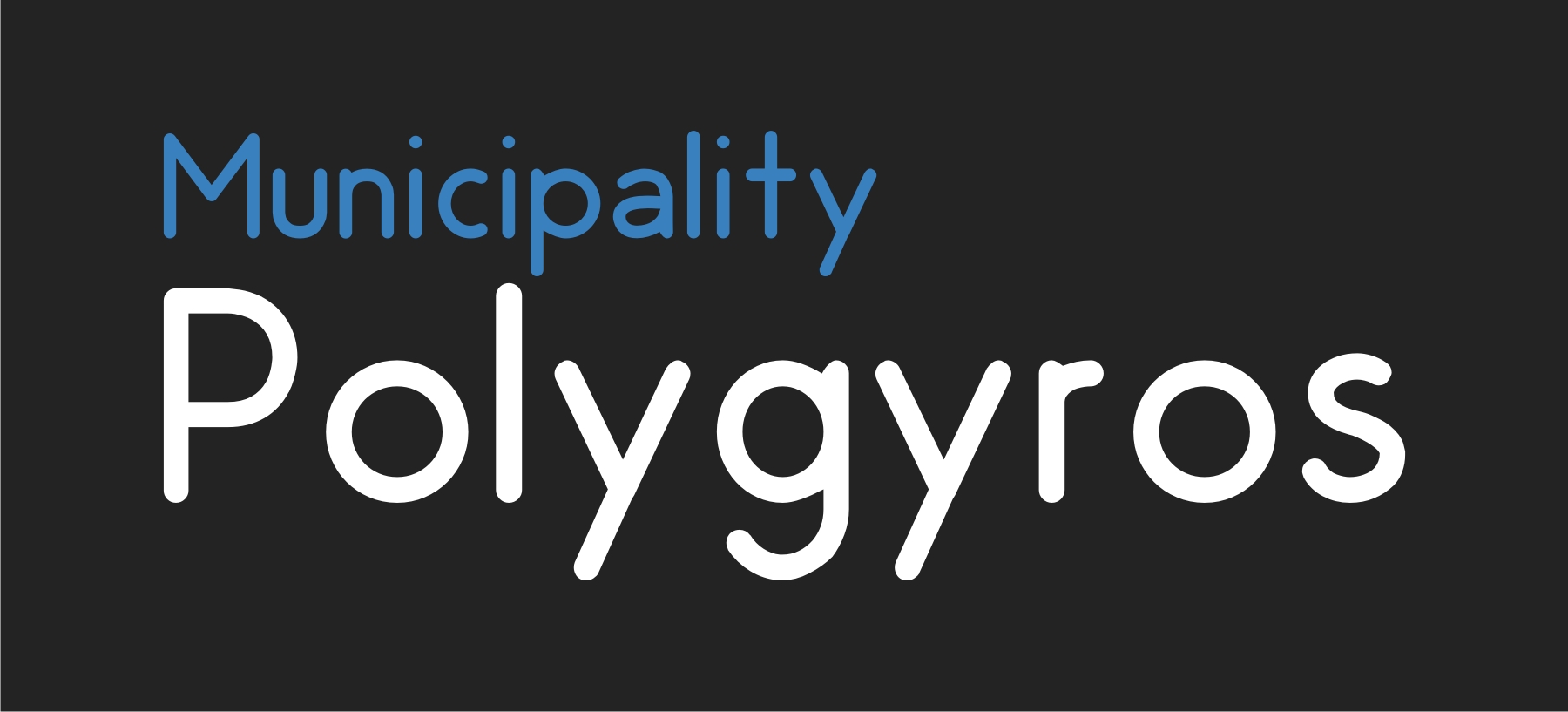
The Municipal Unit of Polygyros consists of the Municipal Department of Polygyros (Gerakini, Kalyves, Patelidas), the Municipal Department of Saint Prodromos, the Municipal Department of Vrastama (Kelli, Plana), the Municipal Department of Olynthos, the Municipal Department of Paleokastro, the Municipal Department of Sana and the Municipal Department of Taxiarhis.
Polygyros
Polygyros lies in the centre of Chalkidiki on the foohills of Mt Holomontas and has an altitude of 560 metres.
In the northern part there is a green slope reaching up to the mountain peak “Tsoukalas” (890m) from where someone can enjoy a panoramic and majestic spectacle: the three peninsulas of Sithonia, Kassandra and Mount Athos, Ammouliani Island and Kelyfos.
On the south of Polygyros, low hills, ravines and streams lead to fertile slopes where the lavish Polygyros’ olive groves spread.
There is an Archaeological Museum in Polygyros which is under reconstruction for the time being. There is in addition a Folklore Museum which is housed in Karagkani’s (former Mayor of the town) Residence. There are also plenty of parks and picturesque squares. The town’ s trademark is Exi Vrysses (The Six Founts).
Remarkable Chapels in Polygyros are the following: the Chapel of The Virgin Mary 0.62 miles away from the town, the Chapel of Prophet Ilias found on top of a hill of the same name, the Chapel of Saint Nikolaos the Orphan, the Chapel of Saint Christophoros, the Chapel of Saint Anargyroi and plenty of others.
A great Cultural Event for Polygyros is the Polygyros Carnival while during the summer months in the Amphitheatre of Polygyros lots of music concerts and theatrical performances are held as part of Polygyros Festival. Traganou’ s Residence houses the Municipal Library of Polygyros where creative activities for the young and the old are held throughout the year.
Agios Prodromos
It is located at the foot of Mt Holomontas, 8.70 miles away from Polygyros.
The population of the village amounts to five hundred (500) inhabitants. İt is noteworthy that the inhabitants come from various places of Greece such as Morea, Epirus, Macedonia and Thrace. Their main occupation is mostly agriculture, livestock farming and tourism. The products produced in the village are grain, livestock products, traditional bread and the famous souvlaki of Agios Prodromos.
The river that crosses the village and is surrounded by lush vegetation is worth visiting. There is in addition the beautiful square which is surrounded by plenty of traditional taverns. The Chapel of Saint Prodromos deserves a special quotation as it is one of the late Byzantine chapels of Chalkidiki with a great significance to the residents of the area.
The inhabitants of Agios Prodromos preserve the customs and habits of their home place. On Good Friday young women dressed in black sing The Passion of the Christ. The traditional festivals are also preserved and therefore on the 9th of May Saint Christophoros is celebrated and on the 29th of August a big feast takes place in the Chapel of Agios Prodromos.
In Agios Prodromos the visitor can enjoy the traditional, picturesque taverns where among other delicacies the famous souvlaki of Agios Prodromos is served.
Vrastama
Vrastama is located at the foot of Mt Holomontas and is characterized as a semi-mountainous village. Its distance from Polygyros is 6.84 miles.
Nowadays the population of Vrastama amounts to eight hundred and fifty (850) permanent residents. Their main occupation is agriculture, olive and grain cultivation as well as firewood production.
For the cultivation and processing of olives there are big oil mill units. Equally important is their occupation with livestock farming and beekeeping and there are also loggers and workers. The village’ s products include olives – oil, grain, honey, wood charcoal and their traditional drink (tsipouro), “koumaro”.
The Church of The Annunciation is definitely worth visiting. Another site worth visiting is the Cave of Saint Efthymios. It is situated in a beautiful place surrounded by waterfalls and pine trees. There, the Saint lived in solitude and dedicated himself to ascetism. Today the visitor can visit the Saint’s cave built on a rock. The Saint is commemorated on the 14th of October.
The inhabitants of Vrastama have also preserved the traditional festivals numbered around 13. The most prominent ones being those of Agioi Anargyroi’s on the first of July, Saint Kyriaki’s on the 7th of July and the Assumption of the Virgin Mary on the 15th of August when the Cultural Association holds a four-day celebration known as “the Koumaro Feast”.
Gerakini
Gerakini is one of the Settlements belonging to the Municipal Department of Polygyros. At the beginning of the previous century Gerakini was a small settlement inhabited by magnesite mine workers. The development of the place started after 1960. The typical products of the area are olives and oil.
Tourism has grown over time in the region with hotels, rooms to let and camping sites.
Kalyves
Kalyves is a large settlement, remarkable, with great economic potential located near the sea between Gerakini and Olynthos. Kalyves was named after the multitude of rural houses - huts - (kalyves in Greek), which the inhabitants of Polygyros had built in the area in order to cultivate their rich estates, in the same way they had done with the silkworms in the past. The inhabitants are mainly engaged in agriculture. Apart from the olive groves which have existed in Kalyves for centuries, thousands of acres of edible olive groves have been developed during the latest years. Along with the neighbouring rich olive groves of Olynthos they constitute the largest production centre of the famous green coarse olives in the entire Prefecture of Chalkidiki. Thousands of tons of olives are produced in the area providing an extremely robust income to the inhabitants and supplying the factories and oil mills of the area whereas large quantities supply factories in other areas as well.
The Patron Saint of Kalyves is Saint Modestos (17th – 18th December) while someone can find plenty of Chapels.
On the beach of Kalyves there used to be the ancient city of Mykiverna, independent and significant. Due to its location, Mykiverna was the seaport of the renowned ancient city of Olynthos. No systematic excavations have been carried out in the area of the ancient city.
In Kalyves there are taverns, cafes, rooms to let and a lot of holiday houses.
Kelli
The distance between the village and Polygyros is 11.18 miles. And the distance from the Municipal Department of Vrastama - of which it is a settlement - is only 3.10 miles. Kelli is a small hamlet where people live off agriculture and livestock farming. Among their occupations, the inhabitants actively participate in the common affairs since the distance that separates them from Vrastama is short and thus they have immediate communication and are actively involved in the activities of their Municipal Department retaining the local colour of Chalkidiki which is a common feature for all the Municipal Departments of the Municipality of Polygyros.
In their occupations, they actively participate in the commons since the distance that separates them from Vrastama is short and thus they have direct communication and actively participate in the activities of their municipal apartment keeping the color of Halkidiki, which characterizes all the municipal apartments of the Municipality of Polygyros.
There is an active Cultural Association, which among other activities is in charge of holding the three-day celebration festivities in honour of Panagouda (8th September).
Important paleontological findings have been spotted in the wider area.
Olynthos
Olynthos is located on the south of the Municipality and is a lowland area. Its distance from Polygyros is 14.91 miles.
Olynthos is the Historical Capital City of the Municipality of Polygyros. Tradition attributes the establishment of the city as well as its name to the hero Olynthos, son of the river god Strymonas, while Herodotus cites that the city was conquered by the Votians of Imathia in the 7th century B.C. when after being persecuted by the Macedonians they moved to Chalkidiki and settled on the Southern Hill. Olynthos was the capital of the Chalkidiki Confederation (The Chalcidian League). Olynthos struggled to maintain their independence from Athens, Sparta and the rising power of the Macedonian King Philip II. It was finally destroyed by King Philip in 348 B.C. while the Olynthiac Speeches delivered by Demosthenes against Philip’ s threats have remained well-known.
The current population of Olynthos amounts to 1,131 inhabitants. Their main occupation is livestock farming and agriculture, which in recent years has developed significantly enough to turn Olynthos into one of the first olive oil-producing areas in Greece in terms of edible olives and green olive oil. The products produced in Olynthos include oil, olives and pistachios.
The places worth visiting in Olynthos are of great significance. Firstly, the Archaeological Site of Olynthos where the visitor can in addition see the Byzantine monuments of the area. The Olynthians have kept their traditional festivals alive and celebrate them with all their grandeur:
Celebration of Saint Athanassios on the 2nd of May
Celebration of Saint George on the 23rd of April
Celebration of Saint Anargyroi on the 1st of July (kourbania) and finally the three-day celebration festivities known as «The Olive Feast» and held by the local Cultural Association.
For the accommodation of visitors, there is a hotel as well as traditional taverns.
For more information on Ancient Olynthos
Paleokastro
It is located on the north of Polygyros in the mountain range of Holomontas. Its distance from Polygyros is 6.21 miles.
The population of Paleokastro amounts to 351 inhabitants. Their main occupation is agriculture and timber production. Some inhabitants are mine workers in the magnesite mines of Gerakini as well as in the quarries of the area.
Tourist attractions of the village is the hiking route of Paleokastro - Saint Paraskevi whereas the old traditional settlement of the village is worth visiting as well. On the old Paleokastro – Polygyros national highway there is the historical bridge of «Kavrolakkas».
The inhabitants of Paleokastro preserve the customs and habits of their home place. On the Day of the Epiphany the Athletic and Cultural Association revives the traditional custom of «Fotaroi». Furthermore, local festivals are celebrated in the village, one of which is the festival of Saint Paraskevi in the Chapel of «Vatonia» where the Festive Great Vespers take place.
In Paleokastro visitors can eat at the village tavern which serves mainly grilled dishes.
Plana
Plana is located at an altitude of 120 metres and at a distance of 13.67 miles away from Polygyros. The area has been known since antiquity and is referred to in the most famous work of the ancient Greek writer Xenophon, Anabasis, as Assa, the place where the Persian troops camped for a period of eight months.
A small hamlet with vivid local Chalkidiki colour and a fully-fledged sense of hospitality.
The few permanent residents have accomplished to maintain the traditions of their land unaltered through their daily occupation with the agriculture and the livestock farming.
The two great festivals of The Holy Apostles on the 28th and 29th of June and of Saint Kyriaki on the 6th and 7th of July show in the best way possible to the visitors and to the younger ones the significance of preserving the tradition and the customs of the our place.
Sana
Sana is located at an altitude of 290 metres and at a distance of 10.56 miles away from Polygyros. Its inhabitants are mainly engaged in livestock farming and at a minor extent in tobacco cultivation and grain cultivation.
As far as the sights of Sana are concerned, the Lake Dam is one of the most outstanding. In addition to being a water reservoir - due to the large area it covers - it is developing into an excellent wetland area as well as a vivarium with the abundance of fish that have flooded and live in its bottom. Moreover, the large stream gorge of the Ammitis River (Vasmoura), the location of Ai Lia and the low hills of the Neeftos ridge are ideal routes for hiking and walking in nature.
From the intersection of Kerasia to the village the journey is of infinite natural beauty with a view of the Volvi Lake, the archaeological sites, the ancient cemetery in the Ai-Lia area and the small recently-restored chapel of the 10th century.
The traditional events that have been organized with great success in the Municipal Department of Sana in recent years are the following:
The Feast of Ai-Lia on the 20th of July, the Feast of Agioi Taxiarches on the 8th of November and the «Tsipouro Feast» celebrated in the main square of the village. The first such feast took place in 1999 by the wine-growers of the village and due to the operation of the traditional tsipouro distilleries in the village. Since then it has been held every year at the beginning of the distillery period, usually on the third Sunday of October.
Taxiarchis
Taxiarchis is built near the top of Holomontas at an altitude of 650 metres. Tradition connects Taxiarchis with Mount Athos and more specifically with the Docheiariou Monastery and the metochion of the Archangel Michael that the Monastery owned in the village. The oldest name of the village was Lokovi and was officially named Taxiarchis after the Patron Saint of the village, the Archangel Michael, in 1928.
Its distance from Polygyros is 15.53 miles.
Its inhabitants’ main occupations are logging, firewood production, agricultural production and livestock farming. Moreover, the builders, the stonemasons and the craftsmen of Taxiarchis are of high repute throughout Chalkidiki. Quite a few women are engaged in weaving, knitting and embroidery while a substantial portion of the inhabitants’ income come from growing fir for Christmas trees. Lastly, more and more inhabitants are engaged in agritourism.
Taxiarchis’ sights are the mountain pass of Holomontas which allows the visitor to relish the dense forest full of oak trees, beech trees, chestnut trees, kermes, pine trees, firs and a variety of other trees, bushes, wild flowers and aromatic plants whereas the view enjoyed in some areas is unique. Bara, Apolymeni Petra, the Pasha’ s Well, the Skismeni Petra, the Agios location, the wild region of Arkoudolakkas are indicative places of interest. Likewise, Tsipotoura Fount at the entrance of the village, Kato Pigadi, the stone built square, the basilica with a dome, the church museum, Hani, several traditionally built houses and a number of churches and chapels scattered in and around the village and the Forest Museum (at the University building) are all worth seeing.
The religious as well as the social life of the village finds its expression in an array of celebrations, festivals, customs, and ceremonies.
Taxiarchis is a popular tourist destination during winter and summertime. There is already the infrastructure to offer warm hospitality to visitors in traditional houses and guesthouses with all the facilities they could need. More and more tourists are attracted by the well-marked old trails, the touring and hiking routes, the horse-riding, the cycling trails, the habitats, the controlled hunting areas and the nature reserves, climbing and mountaineering as well as by the renowned taverns of the place.



